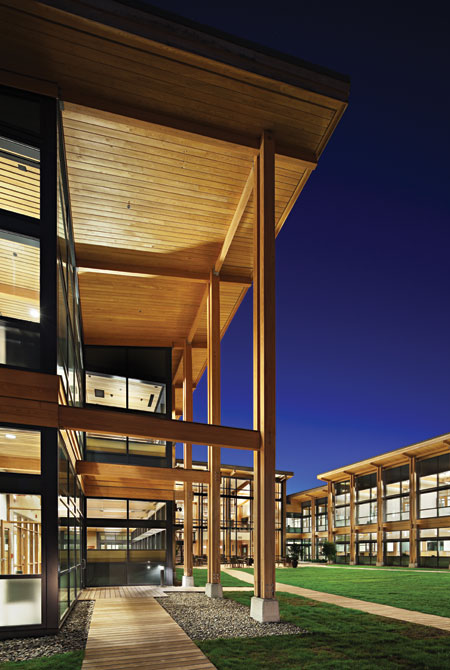Modern Building Codes: Keeping Pace with the Wood Revolution
Fire Protection
Building codes require all building components within a particular type of construction to provide the same level of fire protection regardless of materials used.
Wood-frame construction has an excellent history of code-compliant fire-resistive performance.3 In fact, the IBC allows greater heights and areas for wood buildings than designers may think, in a wider range of construction types.

Photo: Mark Herboth Photography
Live Oak Bank Headquarters
Wilmington, North Carolina
Architect: LS3P Associates Ltd.
Engineer: Woods Engineering
WoodWorks Wood Design Award,
Jury’s Choice, 2015
As a starting point, the IBC specifies a basic allowable area based on a single story, the type of construction and occupancy classification. It then increases the allowable area based on features of the building, including the addition of an automatic sprinkler system, side yard open space, fire walls, augmented exiting and additional stories.
For example, the code allows low-rise, two-story business and mercantile buildings of wood construction to be of unlimited area when they are equipped with an automatic sprinkler system throughout and have 60 feet of fire separation distance between the building and all property lines. Residential wood buildings with sprinklers and exterior walls made from fire retardant-treated wood (FRTW) can be up to five stories in height and have additional “levels” when mezzanines are included. Under the 2012 IBC, mezzanines are permitted to be 33 percent of the floor area below and considered part of that story, although some local jurisdictions may allow a greater percentage. The code also permits the use of wood for many features in buildings required to be of a non-combustible construction type, often even whole roof structures, based on other safety features.
Under the IBC, designers can use fire walls to create separate buildings for building area limitations when additional size is needed and sprinklers either aren't an option or they don't afford the necessary increases for the project's use and site characteristics. In Type V Construction, fire walls are permitted to be of wood-frame construction, allowing designers to divide the structure into separate buildings for purposes of size, each subject to its own height and area limits. Therefore, the size of a building can theoretically be doubled while maintaining the same construction type.









